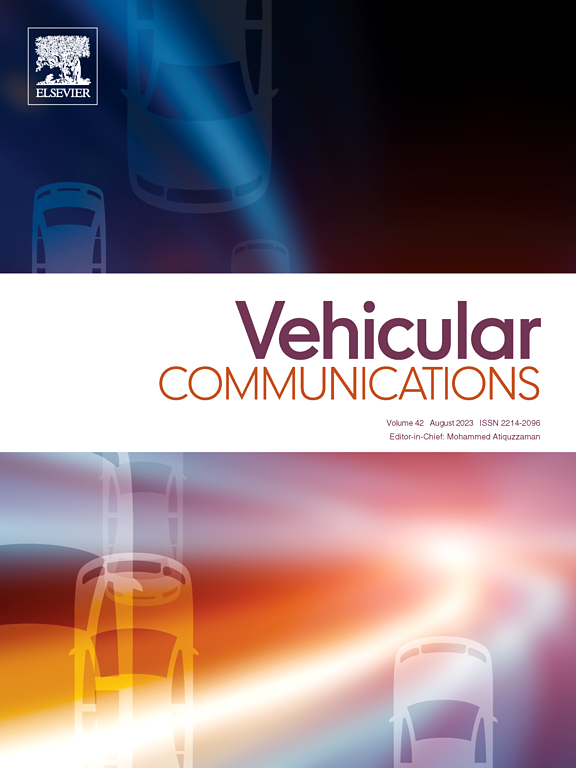RORA: Reinforcement learning based optimal distributed resource allocation strategies in vehicular cognitive radio networks for 6G
IF 6.5
2区 计算机科学
Q1 TELECOMMUNICATIONS
引用次数: 0
Abstract
The next generation (5G/B5G) vehicular cognitive radio networks (VCRNs) flag the track to intelligence-based autonomous driving in the initiation of future wireless networking and make daily vehicular operation more convenient, greener, efficient, and safer. However, with the continuous evolution of vehicles, the vehicular network becomes large-scale, dynamic, and heterogeneous, making it tough to fulfill the strict necessities, such as high security, resource allocation, massive connectivity, and ultralow latency. The combination of cognitive radio (CR) networks (different network coexistence) and machine learning (ML) has arisen as an influential artificial intelligence (AI) approach to make both the communication system and vehicle more adaptable and efficient. Naturally, applying ML to VCRNs has become an active research area and is being extensively considered in industry and academia. In this work, a reinforcement learning (RL) based optimal resource allocation (RORA) technique is proposed to solve the myopic decision-making problem by an autonomous vehicle (RL agent) takes its action to select the power level and optimal sub-band and maximize long-term rewards with a maximum payoff in VCRNs. The aim of this work is to design and implement an intelligent, resource allocation framework that ensures efficient and adaptive spectrum utilization while minimizing communication latency, energy consumption, and transmission cost in VCRNs. As a schema for the realization and capabilities evaluations, the CR networks consisting of LTE cellular network inter-working with Wi-Fi network with constant inter-space between Wi-Fi access points (APs) installed along the pathway is analysed. This framework is further analysed with variable inter-space between Wi-Fi APs. The key research problem addressed in this work is the challenge of optimizing spectrum and power allocation in highly dynamic vehicular environments characterized by rapid mobility, fluctuating network conditions, and interference from multiple vehicular CR nodes. The results show that the proposed RORA technique is more operative and outperforms other resource allocation schemes in terms of prediction accuracy and throughput.
Impact Statement
In this work, we proposed a machine learning-based technique applied to vehicular networks and opportunistic spectrum access parts in cognitive radio networks. The proposed technique envisions ways of enabling AI toward a future intelligent transportation system (ITS), including network intelligentization and the development of intelligent radio (IR).

基于强化学习的6G车载认知无线网络资源最优分配策略
下一代(5G/B5G)车载认知无线网络(vcrn)标志着未来无线网络开启智能自动驾驶的轨道,使日常车辆操作更加便捷、绿色、高效、安全。然而,随着车辆的不断演进,车载网络变得规模化、动态化、异构化,难以满足高安全性、资源分配、海量连接、超低时延等严格要求。认知无线电(CR)网络(不同网络共存)和机器学习(ML)的结合已经成为一种有影响力的人工智能(AI)方法,使通信系统和车辆更具适应性和效率。自然,将ML应用于vcrn已成为一个活跃的研究领域,并正在工业界和学术界广泛考虑。本文提出了一种基于强化学习(RL)的最优资源分配(RORA)技术,用于解决自动驾驶车辆(RL agent)在vcrn中选择功率水平和最优子带的行为,以最大的收益最大化长期回报的近视决策问题。本工作的目的是设计和实现一个智能的资源分配框架,以确保高效和自适应的频谱利用,同时最大限度地降低vcrn中的通信延迟、能耗和传输成本。作为一种实现和能力评估的模式,分析了LTE蜂窝网络与Wi-Fi网络互用、Wi-Fi接入点(ap)沿路径设置恒定间隔空间的CR网络。该框架进一步分析了Wi-Fi ap之间的可变间隔空间。本研究解决的关键问题是在高速移动、波动网络条件和多个车辆CR节点干扰的高动态车辆环境中优化频谱和功率分配的挑战。结果表明,所提出的RORA技术在预测精度和吞吐量方面优于其他资源分配方案。
本文章由计算机程序翻译,如有差异,请以英文原文为准。
求助全文
约1分钟内获得全文
求助全文
来源期刊

Vehicular Communications
Engineering-Electrical and Electronic Engineering
CiteScore
12.70
自引率
10.40%
发文量
88
审稿时长
62 days
期刊介绍:
Vehicular communications is a growing area of communications between vehicles and including roadside communication infrastructure. Advances in wireless communications are making possible sharing of information through real time communications between vehicles and infrastructure. This has led to applications to increase safety of vehicles and communication between passengers and the Internet. Standardization efforts on vehicular communication are also underway to make vehicular transportation safer, greener and easier.
The aim of the journal is to publish high quality peer–reviewed papers in the area of vehicular communications. The scope encompasses all types of communications involving vehicles, including vehicle–to–vehicle and vehicle–to–infrastructure. The scope includes (but not limited to) the following topics related to vehicular communications:
Vehicle to vehicle and vehicle to infrastructure communications
Channel modelling, modulating and coding
Congestion Control and scalability issues
Protocol design, testing and verification
Routing in vehicular networks
Security issues and countermeasures
Deployment and field testing
Reducing energy consumption and enhancing safety of vehicles
Wireless in–car networks
Data collection and dissemination methods
Mobility and handover issues
Safety and driver assistance applications
UAV
Underwater communications
Autonomous cooperative driving
Social networks
Internet of vehicles
Standardization of protocols.
 求助内容:
求助内容: 应助结果提醒方式:
应助结果提醒方式:


